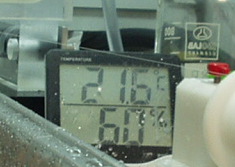▼ Reference
- Batool S S, Imran Z, Qadir M I, Usmann M, Jamil H, Rafiq M A, Hassan M M, Willander M. Comparative Analysis of Ti, Ni, and Au Electrodes on Characteristics of TiO2 Nanofibers for Humidity Sensor Application. J Mater Sci Technol 2013; 29: 411.
- Guo K, Zhou X. Research Report on the Application of MEMS Sensors Based on Copper Oxide Nanofibers in the Braking of Autonomous Vehicles. Journal of Environmental and Public Health 2022; 2022: 5852729. Open Access
- Li Z, Zhang H, Zheng W, Wang W, Huang H, Wang C, MacDiarmid A G, Wei Y. Highly Sensitive and Stable Humidity Nanosensors Based on LiCl Doped TiO2 Electrospun Nanofibers. J. Am. Chem. Soc. 2008; 130: 5036.
- Sheng L, Dajing C, Yuquan C. A surface acoustic wave humidity sensor with high sensitivity based on electrospun MWCNT/Nafion nanofiber films. Nanotechnology 2011; 22: 265504.
- Su M Y, Wang J, Yao P J, Du H Y. High Performance Humidity Sensor Based on Electrospun Zr0.9Mg0.1O2?δ Nanofibers. Chin. Phys. Lett. 2012; 29: 110701.
- Qi Q, Zhang T, Wang L. Improved and excellent humidity sensitivities based on KCl-doped TiO2 electrospun nanofibers. Applied Physics Letters 2008; 93: 023105.
- Urrutia A, Rivero P J, Goicoechea J, Rodriguez Y, Arregui F J, Matias I R. Silver Nanoparticles Loaded Electrospun Nanofibers for Humidity Optical Fiber Sensing. IMCS 2012 - The 14th International Meeting on Chemical Sensors. 1550. DOI 10.5162/IMCS2012/P2.4.16.
- Wang D, Zhang D, Li P, Yang Z, Mi Q, Yu L. Electrospinning of Flexible Poly(vinyl alcohol)/MXene Nanofiber-Based Humidity Sensor Self-Powered by Monolayer Molybdenum Diselenide Piezoelectric Nanogenerator. Nano-Micro Lett. 2021; 13: 57. Open Access
- Wang L, He Y, Hu J, Qi Q, Zhang T. DC humidity sensing properties of BaTiO3 nanofiber sensors with different electrode materials. Sensors and Actuators B 2011; 153: 460.
- Wang X, Ding B, Yu J, Wang M, Pan F. A highly sensitive humidity sensor based on a nanofibrous membrane coated quartz crystal microbalance. Nanotechnology 2010; 21: 055502.
- Xu L, Wang R, Xiao Q, Zhang D, Yong L. Micro Humidity Sensor with High Sensitivity and Quick Response/Recovery Based on ZnO/TiO2 Composite Nanofibers. Chin. Phys. Lett. 2011; 28: 070702.
▼ Credit and Acknowledgement
Author
Wee-Eong TEO View profile
Email: weeeong@yahoo.com
 ElectrospinTech
ElectrospinTech
